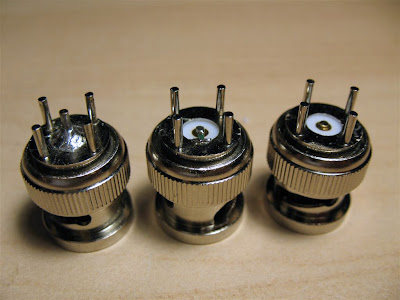For my project I used a PCB from WB6DHW. His interface is a nearly identical clone (electrically) of the G8KBB interface. To be honest, I am less than impressed (other words, which I'll save come to my mind ) with the PCB layout done by WB6DHW - it looked like somebody was learning how to design a PCB and used this project as a practice board. I was almost ready to design my own board (G8KBB's board is excellent but his PCBs are not readily available). Don't mean to bash WB6DHW - just expressing an opinion. At the end of the day tho, I decided to close my eyes and got the bare board from WB6DHW because of its low price - fabricating my own board was going to cost a lot more and wasn't worth the effort/money just for a single piece. All components are from DigiKey, including the Cypress chip and the Hammond die-cast aluminum enclosure housing the interface.
 I had to modify (mill) the PCB in order to fit it in the enclosure. The PCB is raised on stand-offs since the Mini-B USB connector along with some other parts are placed on the bottom side. I prefer to have the much sturdier and more reliable USB-B connector but there wasn't an easy way to modify this board. The Cypress FX2 chip is in a package with fine pitch leads but it wasn't that difficult to solder it pin-by-pin under sufficient magnification. There was no need to install any of the other connectors - I just soldered the wires directly to the board. The enclosure is a tight fit and if I had the connectors installed it would have been difficult to manage the wires inside. The most time-consuming part in this project is wiring the board to the cable and the female DB25 connector according to the schematics and the table provided by Dave G8KBB.
I had to modify (mill) the PCB in order to fit it in the enclosure. The PCB is raised on stand-offs since the Mini-B USB connector along with some other parts are placed on the bottom side. I prefer to have the much sturdier and more reliable USB-B connector but there wasn't an easy way to modify this board. The Cypress FX2 chip is in a package with fine pitch leads but it wasn't that difficult to solder it pin-by-pin under sufficient magnification. There was no need to install any of the other connectors - I just soldered the wires directly to the board. The enclosure is a tight fit and if I had the connectors installed it would have been difficult to manage the wires inside. The most time-consuming part in this project is wiring the board to the cable and the female DB25 connector according to the schematics and the table provided by Dave G8KBB. This is the complete interface. It is rugged yet compact - the only delicate part to worry about is the Mini-B connector. The initial setup is a bit complicated - a Vendor ID and Product ID must be written in the EEPROM in order for the USB micro-controller to properly report the interface in Windows. To accomplish this task, a step-by-step procedure and a piece of configuration software are published on Dave's, G8KBB web site. First, special drivers are installed in Windows to get access to the Cypress FX2 chip and the EEPROM address space. Then, using "USB Configure" (by G8KBB), the appropriate IDs are programmed in the EEPROM according to the hardware in use - version of the interface/VNA and current demand (in case the USB port is used also to power the VNA). This setup is one time deal - afterwards the interface is used with its regular USB drivers.
This is the complete interface. It is rugged yet compact - the only delicate part to worry about is the Mini-B connector. The initial setup is a bit complicated - a Vendor ID and Product ID must be written in the EEPROM in order for the USB micro-controller to properly report the interface in Windows. To accomplish this task, a step-by-step procedure and a piece of configuration software are published on Dave's, G8KBB web site. First, special drivers are installed in Windows to get access to the Cypress FX2 chip and the EEPROM address space. Then, using "USB Configure" (by G8KBB), the appropriate IDs are programmed in the EEPROM according to the hardware in use - version of the interface/VNA and current demand (in case the USB port is used also to power the VNA). This setup is one time deal - afterwards the interface is used with its regular USB drivers.



















